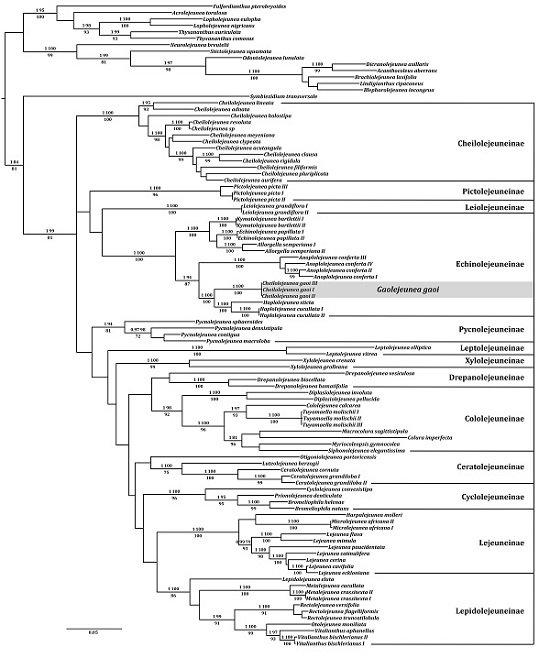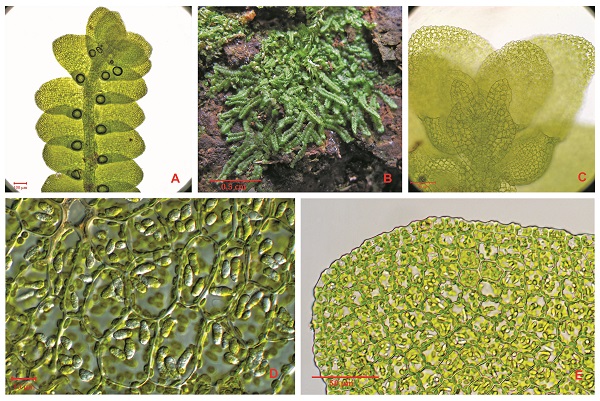Discovered in 1974 by Prof. Chien GAO, an acknowledged authority on Chinese bryology, at Hongqilinchang (now Shiwandashan National Forest Park), Shangsi, Guangxi, Cheilolejeunea gaoi R.L.Zhu, M.L.So et Grolle was a peculiar member of the Chinese Lejeuneaceae. It was described as a new species of Cheilolejeunea (Cheilolejeuneinae, Lejeuneeae) in 2001. However, the presence of Allorgella-type denticulations that formed by two adjacent cells on leaf and underleaf margins, small ovate leaf lobules without distinct teeth, ental hyaline papilla, and finely segmented oil bodies all suggest somewhere else.
Recent works on the phylogeny and systematics revision of Cheilolejeunea have given us opportunities to reevaluate the systematic position of C. gaoi in Lejeuneaceae. Analyses of a three-marker dataset (nrITS, cpDNA rbcL and trnL-F) derived from 85 accessions of Lejeuneeae and 15 outgroup species revealed that C. gaoi belonged to subtribe Echinolejeuneinae, far from Cheilolejeunea. The subtribe Echinolejeuneinae represented a rather morphologically heterogeneous assemblage of genera that share bifid or entire underleaves, Allorgella-type denticulations, and pycnolejeuneoid gynoecial innovations. Morphologically C. gaoi did not fit in five known genera of Echinolejeuneinae. The phylogenetic and morphological data both indicated that C. gaoi merited the recognition as a new genus, Gaolejeunea R.L.Zhu et W.Ye, named for Prof. Chien GAO in commemoration of his great contribution to our knowledge of Chinese bryology.
As an endemic genus of Chinese bryophytes, Gaolejeunea is surprisingly narrowly distributed in its type locality, Shangsi Co., Guangxi, China. This usually epiphytic species is restricted to heavily and critically threatened lowland forests. The national red list of Chinese endangered bryophytes classified this species as critically endangered (CR) based on its small population and habitat, which has been threatened by human activities. In situ or ex situ conservation activities for this species were strongly recommended.
This research was completed by Dr. Wen YE from South China Botanical Garden, Chinese Academy of Sciences, in coordination with Prof. Rui-Liang Zhu from East China Normal University. The work was funded by the National Natural Science Foundation of China (nos. 31370238, 31500170、31770224), and the China Scholarship Council (scholarship no. 2009614064). The related article titled “Gaolejeunea, a new genus from China and new member of subtribe Echinolejeuneinae (Lejeuneaceae, Marchantiophyta)” has been published in The Bryologist (121(1): 41-48. 2018, https://doi.org/10.1639/0007-2745-121.1.041).

Figure 1. A 50% majority-rule phylogram derived from Bayesian inference of the combined nrITS, rbcL and trnL-F showing systematic position of Gaolejeunea.

Figure 2. Gaolejeunea gaoi. A. Plant (ventral view). B. Habitat. C. Tip of a branch showing the shape of the underleaves. D. Oil bodies in leaf cells. E. Marginal leaf denticulations of Allorgella-type.



